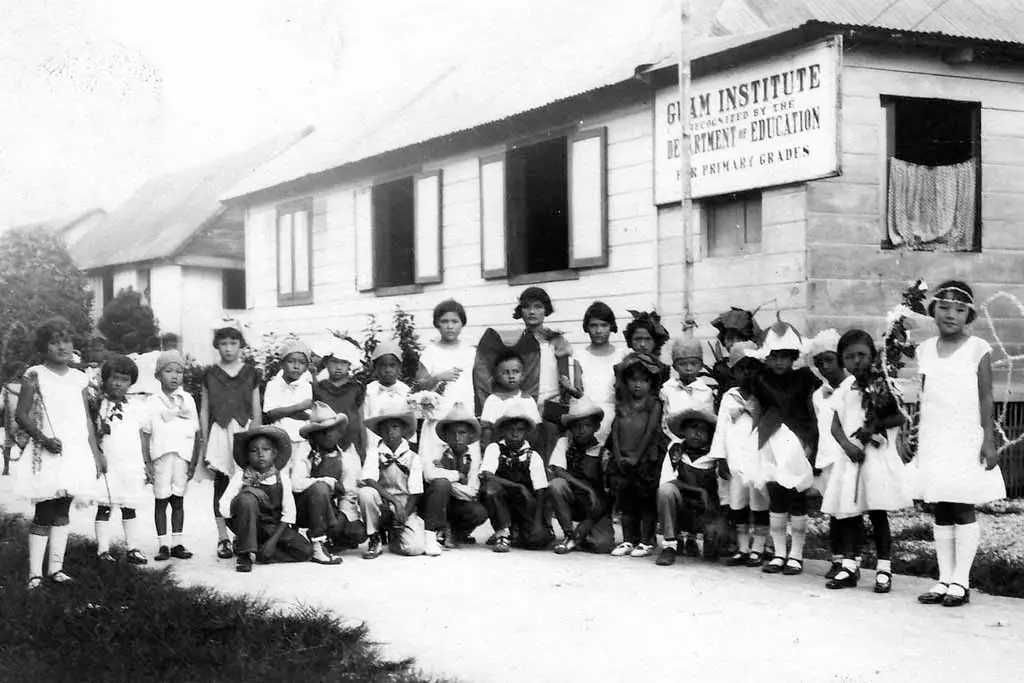Private Schooling During the US Naval Era

Table of Contents
Share This
Inconsistency in educational opportunities
Since Governor Richard P. Leary, US Navy, issued General Order No. 12 on 22 January 1900—the development of public education in Guam — administrative policy and leadership of the Department of Education was rife with inconsistency and, at times, encouraged student absenteeism. Two primary reasons for this inconsistency were the lack of qualified teachers of English and adequate funding from island coffers and the US Congress.
A year before General Order No. 12 was promulgated in Guam, US Navy Lieutenant William E. Safford, tutored basic English free-of-charge to about 50 pupils, ranging from the age of five to 50 years, three nights a week. He wrote:
The only trouble is, we have not income enough from the island to pay higher salaries (to teachers); and we want the government to be self-supporting. To meet the increased expense of the schools we are to have a customhouse.
Joining Safford as an English teacher was Rosie Custino. Rosie was the daughter of Luis Custino, a CHamoru/Chamorro whaler who had settled in Honolulu, Hawaii before returning to Guam at the turn of the century. Rosie Custino taught English at the first American Private School — reportedly an extension of the Protestant Mission in Guam created by Luis and Jose Custino (formerly Castro). She taught adults over the age of 40, including Francisco and John Taitano, Vicente and Pedro Martinez, Jose Roberto; Jose Cruz, Manuel Flores, Manuel Torres; Joaquin Perez, Mrs. Elliot, Mrs. Underwood; Mrs. Peterson, Mrs. Gav, and Mrs. Ojeda.
A year later, in 1900, Navy Lieutenant Albert Mortiz, chief engineer aboard the USS Yosemite, “held private (English) classes in Agana” and, within the same time frame, “American missionaries of the American Board of Missions arrived in Guam and commenced to teach English. Reverend Francis Marion Price, his wife, Sarah and Miss Mary Channel were the first teachers connected with this organization.”
Schooling options for elite
Despite the lack of funding and qualified educators in English, in addition to disinterested Naval governors, and inadequate schools, the public education system did expand, especially during Governor Edward J. Dorn’s tenure from 1907 to 1910. Dorn’s expansion of public education would be reversed by 1911, when Governor George R. Salisbury “allowed non-attendance if (the student’s) permanent residence is more than two miles from the nearest school.” When Salisbury was relieved of duty in 1912, education expenditures totaled $5,000 per year; six years later, that figure jumped to $14,000 per year, still lower than money given as bounty for killing rats and iguanas.
Public education policy vacillated in the first two decades of American occupation with each succeeding governor who, according to General Order No. 12, served as the director of the Department of Education whether they were qualified or not.
Children of the elite and children of American-Chamorro marriages generally were tutored at home, an early version of home schooling. It wasn’t racial, rather it was assumed that military dependents would go to separate schools because they were American.
It is no wonder then that the elite Chamorros and American dependents looked into creating formal private education for their children. In February 1917, Crow’s Nest Private School was opened for Chamorro children, and several months later, American children were admitted. It appears that wives of US military personnel taught at the school.
A report in the Guam News Letter stated:
The attendance has increased at such a rate that additional teachers are constantly being taken on. The teaching force at present is composed of Mrs. Allan E. Peck, Mrs. Carroll Paul, Mrs. Albert E. Sanderson, Mrs. Oliver P. Smith, Miss Julia Martinez, Miss Pilar Salas, Miss Ana Aguon, Miss Guadalupe Sablan, and Miss Isabel Taitano Perez.
For unknown reasons, the school closed sixteen months later on 24 June 1918.
The Guam Institute and American schools
Further experiments in private schooling continued, though a decade later. In the late-1920s, Nieves M. Flores opened the Guam Institute in a house owned by Castro De La Cruz on Padre Palomo Street in Hagåtña before settling into the second floor of Jose P. Lujan’s house just across the street. The institute started as an elementary school but incorporated all twelve grades by 1936. Fourteen teachers—seven industrial arts and seven academic—taught between 150 and 200 students, each of whom paid $1 —and later $1.50 per month for tuition. The school was regulated by the Naval government through monthly visits and examinations and was characterized as being on par with public schools (in the United States) by Naval officials. It closed when Japanese forces landed in Guam on 10 December 1941 and never reopened.
The Naval government in 1930 created two schools for children of American personnel: one in Hagåtña called the American School; the other in Sumay named after Marine Corps General John Meyers. Funds for the American schools came from parents and other interested citizens.
For further reading
Albert, Francis Lee. “History of the Department of Education in Guam During the American Administration.” Guam Recorder 8, no. 7 (1931): 373, 378-386.
Rogers, Robert. Destiny’s Landfall: A History of Guam. Honolulu: University of Hawai’i Press, 1995.
Ronck, Ronn. “Notes on Micronesia.” Islander, Pacific Sunday News, 22 May 1977.
Sanchez, Pedro C. Guahan Guam: The History of Our Island. Hagåtña: Sanchez Publishing House, 1987.
Underwood, Robert A. “American Education and the Acculturation of the Chamorros of Guam.” EdD diss., University of Southern California, 1987.
US Naval Administration of Guam. “End of Crow’s Nest School.” Guam News Letter 10, no. 1 (July 1918).
–––. “Crow’s Nest Private School.” Guam News Letter 9, no. 9 (March 1918).
